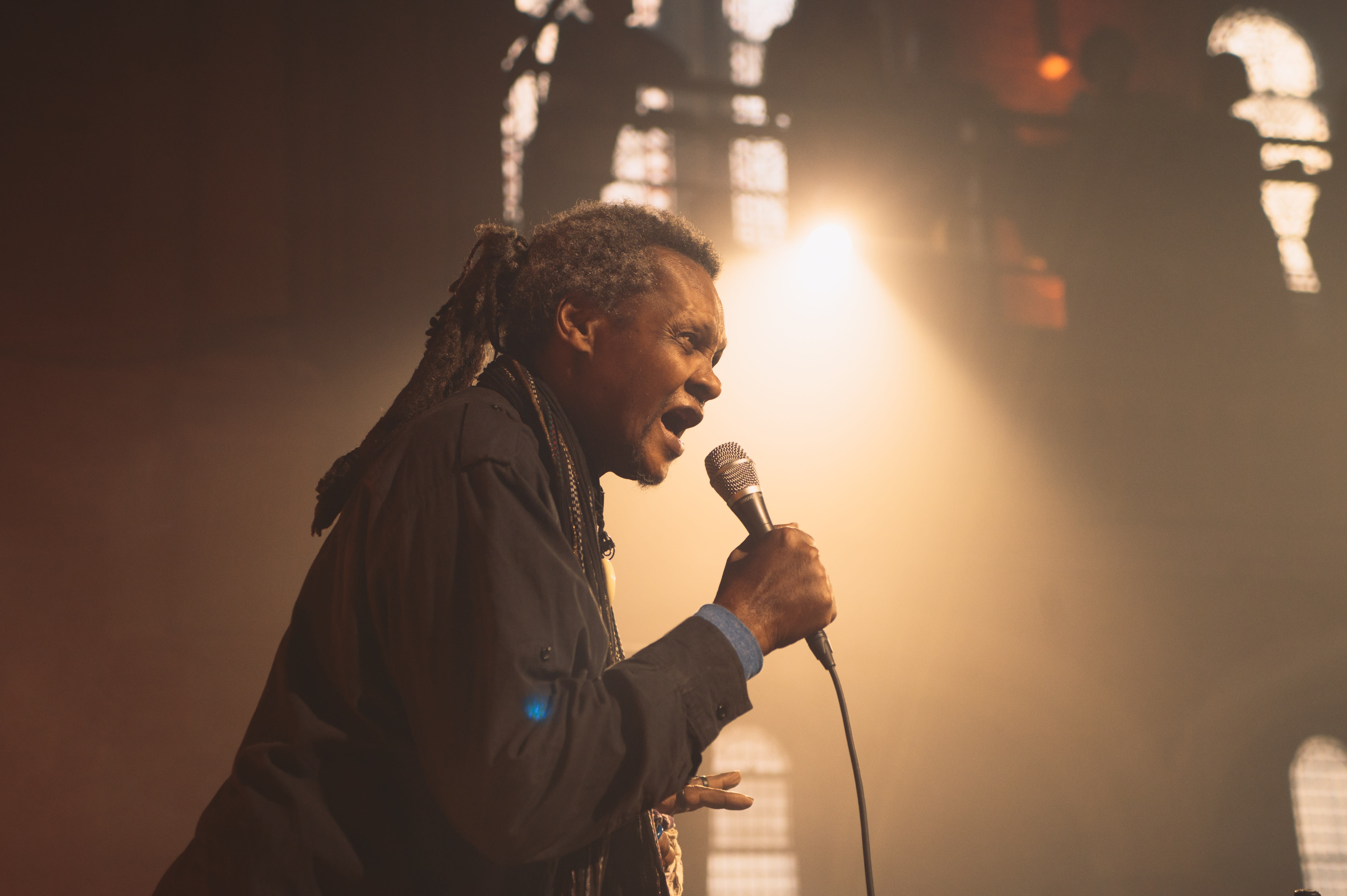June 2022 On a Saturday evening on central London's Shaftesbury Avenue in the 'work-in-progress' venue Stone Nest, Alabama-born artist and musician Lonnie Holley sat behind his keyboard. A patchwork quilt wrapped the keyboard almost completely, except for the keys on which Holley's ringed hands gently rested. The quilt was made by Mary McCarthy using recycled materials and is based on one of Holley's woodblock prints. It features a profile of a face, framed by different blue patches of fabric. The wrapped keyboard becomes an artwork itself, encompassing Holley's multidiscipli nary practice as a whole.
Holley's performance at Stone Nest on 14 May marked the opening of his exhibition The Growth of Communication at Edel Assanti, which features salvaged objects that he collected during recent trips across the UK. These objects were assembled around the same time he filmed The Edge of What - a site-specific performance film organised by Artangel and set in Orford Ness, a former military testing site during the world wars that is now a nature reserve for migrating birds.
On the face of it, the common element between the performance, the exhibition, and the film is their tangible connection to the UK; what really connects them, however, is how Holley assembles singular sounds and discarded objects into complete songs and artworks that portray a complex interplay of racial injustice, poverty and the environment as a collective problem (it is perhaps no surprise that his family thought he would be a preacher given his capacity to stir crowds).

Lonnie Holley Live at Stone Nest, 2022. Photography: Aiyush Pachnanda. Courtesy of Artangel and Edel Assanti.
Holley began his performance by clarifying that he ‘chose songs about the world' that reflected the present. Often referred to as 'improvisations' - he never per forms the same song twice - Holley's songs can only be relived through one's memory. The lyrics I remember most vividly are, 'I was in the nest when the war broke out', repeated with intensity and echoed by his former student, Lee Baines, as he supported Holley on stage with vocals and guitar. While listening to this song in particular, I could not help but think of one of Holley's works on display at the gallery, I Knew They Were Mine, 2020, an assemblage consisting of an old wooden with chipped white paint that frames the root of a tree. The root is the central focus of the assemblage becoming, as Holley explained to the audience at his exhibition opening, a celebratory and 'mighty' marker of nature, rather than a piece of 'driftwood' washing away. The 'nest' in Holley's song and the doorframe in the artwork could be sharing a similar role - while the frame 'protects' the mighty root, the nest could act as a figurative shield from the war.
Yet, even though the doorframe is stripped from its original function, we are still reminded of its past, its side marked with handwritten barely decipherable words. Elsewhere in the exhibition, similarly obscured texts can be discerned such as 'Covent Gdn & Borough Mkts' printed on a wooden milkcrate in The Growth of Communication and 'Manchester' carved on the wooden ruler in Repossessed by the Rules. These details in Holley's chosen objects act as reminders of their original purposes, as they were created in and belong to a different time and place than ours. Holley has brought them to our present by assembling them in ways that strip away their original functions: the milkcrate frames a telephone with cables that have been shaped into human silhouettes, while the wooden ruler stands vertically on its long edge supported by two padlocks.
As I continued listening to Holley's performance at Stone Nest, I understood that his songs were also a coming-together of different lived experiences - the vibrating keys of the keyboard followed the tempo kept by Baines' heel, while the chords of the guitar gently echoed Holley's deep voice. Both his songs and his artworks are raw and ephemeral markers of his practice - songs that cannot be adjusted or fixed as they are only ever played once, and artworks that use abandoned and discarded objects, no longer needed by their past owners. Holley decontextualises each sound and each object and then recontextualises them in a different setting, making us reflect on their place in our present moment.
Through Holley's practice, we learn a new way of building our perception of reality that contradicts the constant and rapid influx of information we are accustomed to today. Holley gives us the time and the space to experience individual instances that, slowly and patiently, allow us to discover for ourselves the complete wholes these might form into.



